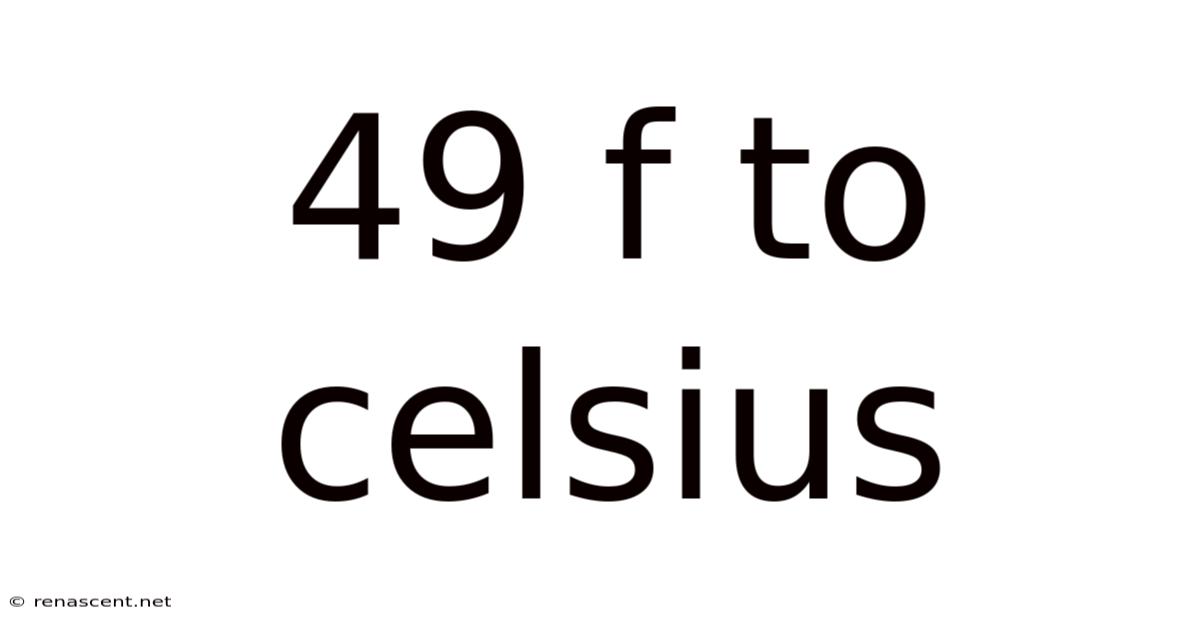49 F To Celsius
renascent
Sep 21, 2025 · 5 min read

Table of Contents
Decoding 49°F to Celsius: A Comprehensive Guide to Temperature Conversions
Converting Fahrenheit (°F) to Celsius (°C) might seem like a simple task, but understanding the underlying principles and the practical applications of this conversion is crucial, especially in a world increasingly reliant on standardized units of measurement. This comprehensive guide delves into the process of converting 49°F to Celsius, explaining the formula, providing step-by-step instructions, and exploring the significance of this specific temperature in various contexts. We'll also tackle common questions and misconceptions surrounding temperature conversions. Whether you're a student, a professional, or simply curious about the world around you, this guide will equip you with a thorough understanding of Fahrenheit-to-Celsius conversion.
Understanding the Fahrenheit and Celsius Scales
Before diving into the conversion, let's briefly review the two temperature scales. The Fahrenheit scale, primarily used in the United States, defines the freezing point of water as 32°F and the boiling point as 212°F. The Celsius scale, used globally, sets the freezing point of water at 0°C and the boiling point at 100°C. This difference in reference points is the key to understanding the conversion process.
The Formula: From Fahrenheit to Celsius
The conversion from Fahrenheit to Celsius is governed by a simple yet elegant formula:
°C = (°F - 32) × 5/9
This formula essentially adjusts the Fahrenheit reading relative to the freezing point of water (32°F) and then scales it to the Celsius scale using the ratio 5/9 (reflecting the different ranges between freezing and boiling points on each scale).
Step-by-Step Conversion of 49°F to Celsius
Now, let's apply the formula to convert 49°F to Celsius:
-
Subtract 32: 49°F - 32°F = 17°F
-
Multiply by 5/9: 17°F × 5/9 ≈ 9.44°C
Therefore, 49°F is approximately equal to 9.44°C.
What Does 9.44°C Mean?
9.44°C represents a moderately cool temperature. It's a temperature you might experience on a slightly chilly day in spring or autumn, depending on location and other weather factors. It’s significantly cooler than room temperature but not excessively cold. This temperature has various implications across different fields:
Implications in Everyday Life
-
Clothing: At 9.44°C, you'd likely need a light jacket or sweater for comfortable outdoor activities.
-
Outdoor Activities: Many outdoor activities remain feasible at this temperature, although prolonged exposure might lead to discomfort.
-
Agriculture: This temperature can impact plant growth and development, with some plants needing protection from potential frost.
-
Human Comfort: Most individuals would find 9.44°C comfortable indoors, but outdoor comfort would depend on factors like wind and humidity.
Implications in Science and Industry
-
Chemical Reactions: Many chemical reactions are temperature-dependent, and 9.44°C could be a significant factor in reaction rates and equilibrium.
-
Material Science: The properties of materials, such as strength and elasticity, can vary with temperature. 9.44°C might influence the behavior of certain materials in specific applications.
-
Meteorology: This temperature is a common range in temperate climates and is crucial data for weather forecasting and climate analysis.
Beyond the Conversion: Exploring Temperature Scales
While the Fahrenheit-to-Celsius conversion is essential, it’s also beneficial to understand the historical context and the advantages of other temperature scales like Kelvin.
The Kelvin scale, the absolute temperature scale, is based on absolute zero, the theoretical temperature at which all molecular motion ceases. Absolute zero is 0 Kelvin (K), which is equivalent to -273.15°C or -459.67°F. The Kelvin scale is widely used in scientific research and engineering, particularly in fields such as thermodynamics and astrophysics.
Common Misconceptions and FAQs
Let's address some frequent misunderstandings and questions related to temperature conversions:
Q: Can I use a different formula to convert Fahrenheit to Celsius?
A: While other methods exist, the formula (°F - 32) × 5/9 remains the most straightforward and accurate way to perform the conversion. Any alternative method should ultimately yield the same result.
Q: Why is the conversion factor 5/9?
A: The 5/9 factor reflects the difference in the size of the degrees between the two scales. The range between the freezing and boiling points of water is 180°F (212°F - 32°F) and 100°C (100°C - 0°C). The ratio of these ranges is 100/180, which simplifies to 5/9.
Q: Is it always necessary to be precise to two decimal places?
A: The level of precision required depends on the application. For everyday purposes, rounding to the nearest degree might suffice. However, scientific and engineering applications often demand greater accuracy.
Q: What about converting Celsius to Fahrenheit?
A: The reverse conversion uses the formula: °F = (°C × 9/5) + 32.
Conclusion: Mastering Temperature Conversions
Converting 49°F to Celsius, resulting in approximately 9.44°C, is more than a simple mathematical calculation. It's a gateway to understanding the fundamental principles of temperature measurement and their implications across numerous disciplines. This guide has provided not just a step-by-step conversion but also a broader context of temperature scales and their applications, empowering you to confidently navigate temperature conversions in various situations. Remember, accuracy and understanding are key when dealing with temperature conversions, and this guide provides the foundation for both. The knowledge gained extends far beyond a simple numerical conversion, fostering a deeper appreciation for the science behind the numbers.
Latest Posts
Latest Posts
-
57 Divided By 2
Sep 21, 2025
-
26 2 Miles Into Kilometers
Sep 21, 2025
-
Converter Kpa To Psi
Sep 21, 2025
-
325 F In Centigrade
Sep 21, 2025
-
3 Percent Of 68
Sep 21, 2025
Related Post
Thank you for visiting our website which covers about 49 F To Celsius . We hope the information provided has been useful to you. Feel free to contact us if you have any questions or need further assistance. See you next time and don't miss to bookmark.